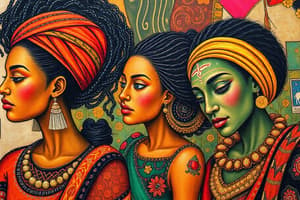Podcast
Questions and Answers
What has shaped the narrow understanding of art among some educators?
What has shaped the narrow understanding of art among some educators?
- Diverse artistic influences from all over the world.
- Prejudiced notions concerning race and gender. (correct)
- Cultural appreciation of crafts and art.
- The belief that art is subjective and personal.
Which of the following assumptions about art does the text suggest should be challenged?
Which of the following assumptions about art does the text suggest should be challenged?
- Individual aesthetics take priority over cultural meaning. (correct)
- Great art is produced regardless of access to materials.
- Art exists in relation to religious beliefs.
- Arts and crafts are perceived as equally important.
How is ethnocentrism characterized in relation to racism?
How is ethnocentrism characterized in relation to racism?
- It is a specific form of art that celebrates local traditions.
- It is an implicit part of racism. (correct)
- It encourages appreciation of diverse artistic expressions.
- It serves to unify different cultures through shared experiences.
What has been excluded from the dominant Western artistic canons?
What has been excluded from the dominant Western artistic canons?
What does the text imply about teaching in art education?
What does the text imply about teaching in art education?
What role do power dynamics play in the understanding of art, according to the text?
What role do power dynamics play in the understanding of art, according to the text?
What must art educators confront to improve the curriculum?
What must art educators confront to improve the curriculum?
What is the term used to describe the most naive form of ethnocentrism?
What is the term used to describe the most naive form of ethnocentrism?
How does Sumner characterize a group exhibiting ethnocentric behavior?
How does Sumner characterize a group exhibiting ethnocentric behavior?
What do ethnocentric attitudes often regard other cultures as?
What do ethnocentric attitudes often regard other cultures as?
What did recent letters in Art Education suggest about color relationships?
What did recent letters in Art Education suggest about color relationships?
Which philosopher's views reflect a universalistic definition of man during the European Enlightenment?
Which philosopher's views reflect a universalistic definition of man during the European Enlightenment?
What does the term 'egocentrism' relate to in comparison to ethnocentrism?
What does the term 'egocentrism' relate to in comparison to ethnocentrism?
Which of the following statements exemplifies ethnocentrism?
Which of the following statements exemplifies ethnocentrism?
What characteristic describes an ethnocentric individual's worldview?
What characteristic describes an ethnocentric individual's worldview?
According to Sumner, what kind of pride do ethnocentric groups typically exhibit?
According to Sumner, what kind of pride do ethnocentric groups typically exhibit?
What is one primary goal of art education as mentioned?
What is one primary goal of art education as mentioned?
How can art students contribute to the classroom environment?
How can art students contribute to the classroom environment?
Which publication first addressed cultural pluralism in art education?
Which publication first addressed cultural pluralism in art education?
What influenced the early multicultural approaches to art education in the United States?
What influenced the early multicultural approaches to art education in the United States?
Who is noted for their contributions to multiculturalism in art education from the 1965 seminar?
Who is noted for their contributions to multiculturalism in art education from the 1965 seminar?
What was a common belief about non-white individuals regarding their contributions to civilization?
What was a common belief about non-white individuals regarding their contributions to civilization?
Who is credited with the early classification of races, including a hierarchy that included an animal-like category?
Who is credited with the early classification of races, including a hierarchy that included an animal-like category?
What stereotype was commonly associated with black people according to early European literature?
What stereotype was commonly associated with black people according to early European literature?
Which group was NOT mentioned as being subject to scrutiny regarding their intellectual capabilities?
Which group was NOT mentioned as being subject to scrutiny regarding their intellectual capabilities?
What impact did racial craniometry have on art education?
What impact did racial craniometry have on art education?
What was emphasized as a determining factor for philosophical classification?
What was emphasized as a determining factor for philosophical classification?
Which statement reflects the attitude of the time towards women and people of color?
Which statement reflects the attitude of the time towards women and people of color?
During which period did the Western study of aesthetics begin?
During which period did the Western study of aesthetics begin?
What contributed to the judgment of non-whites regarding their philosophy and way of life?
What contributed to the judgment of non-whites regarding their philosophy and way of life?
In what way were women also characterized by the dominant European males' perspectives?
In what way were women also characterized by the dominant European males' perspectives?
What is the title of Zerffi's influential work on art history?
What is the title of Zerffi's influential work on art history?
Who was the manual dedicated to by Zerffi?
Who was the manual dedicated to by Zerffi?
What aspect of art does Zerffi's analysis in his manual address?
What aspect of art does Zerffi's analysis in his manual address?
What belief influenced Zerffi's views on art?
What belief influenced Zerffi's views on art?
How did Victorian racial attitudes affect discussions of race, according to the content?
How did Victorian racial attitudes affect discussions of race, according to the content?
What does Marsden suggest about the essence of racism?
What does Marsden suggest about the essence of racism?
What misleading type of scientific inquiry did Zerffi cite?
What misleading type of scientific inquiry did Zerffi cite?
What character trait did Zerffi attribute to 'the Negro' in his comments?
What character trait did Zerffi attribute to 'the Negro' in his comments?
What is identified as a source of Zerffi's racial perspectives on art?
What is identified as a source of Zerffi's racial perspectives on art?
How did the Victorian era influence the authority of racial observations?
How did the Victorian era influence the authority of racial observations?
Flashcards
Eurocentric Bias
Eurocentric Bias
The belief that European art is superior and should be the primary focus in art education.
Western Art Canons
Western Art Canons
A set of accepted standards for 'good' art, heavily influenced by European traditions and often excluding other cultures.
Ethnocentrism in Art
Ethnocentrism in Art
The belief that our own culture's art is better than others, leading to an exclusion of diverse perspectives.
Formalist Aesthetics
Formalist Aesthetics
Signup and view all the flashcards
Individual Genius
Individual Genius
Signup and view all the flashcards
Multicultural Art Education
Multicultural Art Education
Signup and view all the flashcards
Art as Culture-Bound
Art as Culture-Bound
Signup and view all the flashcards
Zerffi's Impact
Zerffi's Impact
Signup and view all the flashcards
Poynter's Influence
Poynter's Influence
Signup and view all the flashcards
Craniometric Analysis
Craniometric Analysis
Signup and view all the flashcards
Victorian Racial Attitudes
Victorian Racial Attitudes
Signup and view all the flashcards
Racism in Art
Racism in Art
Signup and view all the flashcards
Scientific Bias
Scientific Bias
Signup and view all the flashcards
Everyday Prejudice
Everyday Prejudice
Signup and view all the flashcards
Anthropological Societies
Anthropological Societies
Signup and view all the flashcards
Dubious Studies
Dubious Studies
Signup and view all the flashcards
Zerffi's View of 'The Negro'
Zerffi's View of 'The Negro'
Signup and view all the flashcards
Ethnocentrism
Ethnocentrism
Signup and view all the flashcards
Phenomenal Absolutism
Phenomenal Absolutism
Signup and view all the flashcards
Sumner's Definition of Ethnocentrism
Sumner's Definition of Ethnocentrism
Signup and view all the flashcards
Formalist Aesthetics and Ethnocentrism
Formalist Aesthetics and Ethnocentrism
Signup and view all the flashcards
Art Education and Ethnocentric Views
Art Education and Ethnocentric Views
Signup and view all the flashcards
Universalism vs. Ethnocentrism
Universalism vs. Ethnocentrism
Signup and view all the flashcards
Racism and Ethnocentric Bias
Racism and Ethnocentric Bias
Signup and view all the flashcards
The Problem with 'Trick' in Art Teaching
The Problem with 'Trick' in Art Teaching
Signup and view all the flashcards
Ethnocentrism in Art Education: Key Point
Ethnocentrism in Art Education: Key Point
Signup and view all the flashcards
Craniometry
Craniometry
Signup and view all the flashcards
Linnaeus's Classification
Linnaeus's Classification
Signup and view all the flashcards
Hume's Argument
Hume's Argument
Signup and view all the flashcards
Art & 'Proper Intellectual Equipment'
Art & 'Proper Intellectual Equipment'
Signup and view all the flashcards
Stereotyped 'Black' Attributes
Stereotyped 'Black' Attributes
Signup and view all the flashcards
Western Aesthetic Standards
Western Aesthetic Standards
Signup and view all the flashcards
Art vs. Craft
Art vs. Craft
Signup and view all the flashcards
Elitist Aesthetic Theory
Elitist Aesthetic Theory
Signup and view all the flashcards
Influence on Art Education
Influence on Art Education
Signup and view all the flashcards
Cultural Pluralism in Art
Cultural Pluralism in Art
Signup and view all the flashcards
McFee's Contribution
McFee's Contribution
Signup and view all the flashcards
Grigsby's Impact
Grigsby's Impact
Signup and view all the flashcards
Student-Teacher Collaboration
Student-Teacher Collaboration
Signup and view all the flashcards
Community Involvement
Community Involvement
Signup and view all the flashcards
Study Notes
Ethno- and Egocentrism in Art Curriculum
- Elitist and prejudiced assumptions about art originate in biased understandings of race and gender, primarily portraying European male artists as the sole producers of great art. These viewpoints are rooted in Eurocentric notions.
- Eurocentric male-dominated theories and social orderings (both biblical and pseudoscientific) significantly shaped, and continue to affect, art education.
- Art education exhibits ethnocentrism in its curricula in North American schools, which often favor specific notions of "good art" over others, perceived as Eurocentric, culture-bound, elitist, and racist.
- Art curricula often exclude works and perspectives of various cultures. Art educators must address these biases in order to move toward a more inclusive multicultural curriculum.
- Power structures often marginalize differing art forms, distorting the perception of artistic value. Power imbalances in art education promote a hierarchy based on certain cultures and traditions.
- Those in power use art to distinguish themselves from others, emphasizing formalist aesthetics (culture-free) to enhance their status.
- Multicultural education is essential for students' future development, demanding curricula that celebrate diverse artistic traditions.
- Western art canons promote biased assumptions. Best art being made by Europeans, oil painting, sculpture, architecture as most important forms, significant difference between art and craft, and best art being produced by men.
Culture-Bound Assumptions About Art
- Dominant Western art canons assume the best art is produced by Europeans, predominantly focusing on oil painting, sculpture, and architecture.
- A hierarchical distinction exists between art and craft.
- Art is perceived as being created by individual geniuses.
- Judgments about art focus on elements like arrangement of lines, colors, shapes, textures, realism, proportion, media use, and expressiveness according to pre-conceived standards.
- Sociocultural meaning is considered secondary to aesthetic responses.
Ethnocentrism
- Ethnocentrism (judging other cultures based on one's own culture) is implicit in racism. It involves viewing one's culture as superior, often associated with power, wealth, leisure, and white males.
- In the past, art educators have held ethnocentric views, viewing their own art as more worthwhile than others. This contributes to culturally biased curricula.
Racism and Art
- Nineteenth-century art educational thought (like that of Zerffi) demonstrated racist biases, particularly in defining art forms produced by non-white races as inferior.
- The concept of "racial inferiority" and "cultural inferiority" were common throughout nineteenth and early twentieth-century art education thinking and practice. These biased perspectives lead to exclusion and devaluation of non-white and female artists.
Cultural Contexts in Art Education
- Diverse cultural contexts must be respected when teaching art historically and contemporaneously.
- Understanding different cultural values, artistic traditions, and perspectives is crucial for inclusivity, appreciation of diverse arts, and fair evaluation of art works.
Studying That Suits You
Use AI to generate personalized quizzes and flashcards to suit your learning preferences.




